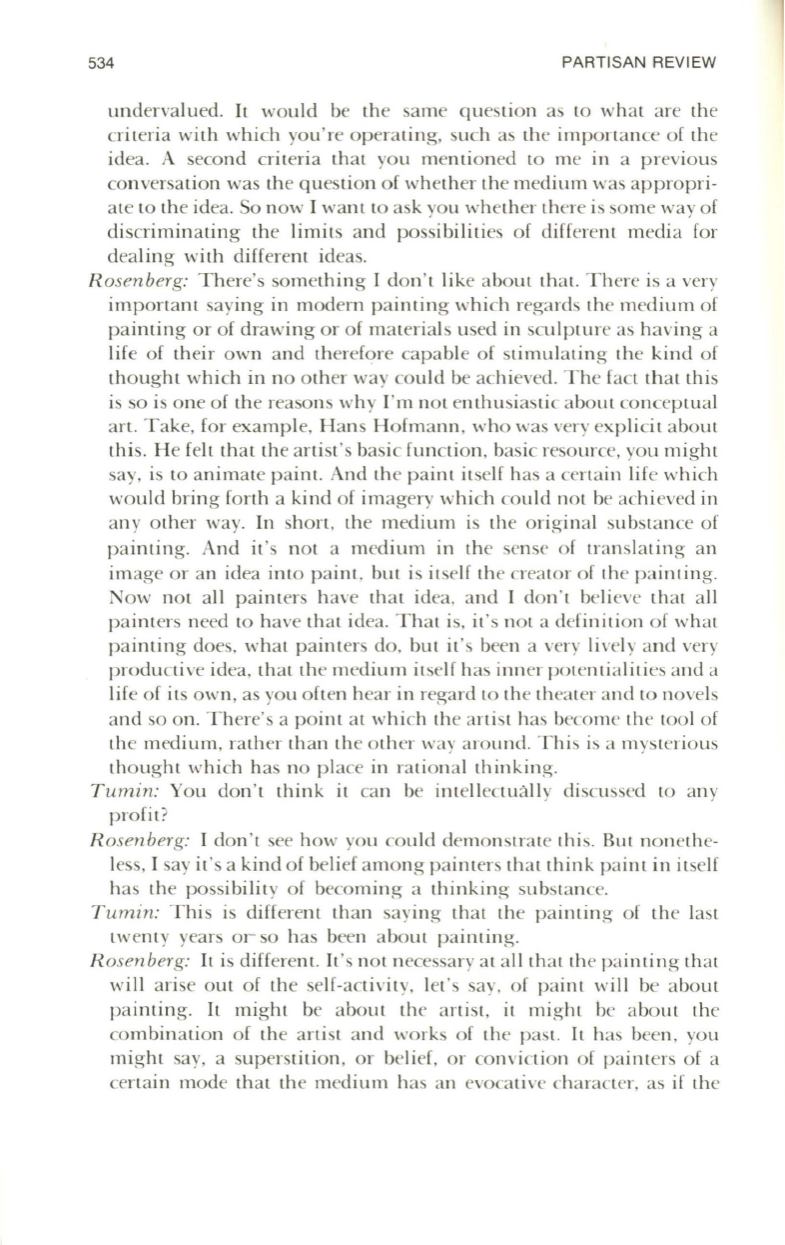
534
PARTISAN REVIEW
underva lued. It would be the same quest ion as to what a re the
cr iteria with whi ch you 're opera ting, such as the impo rtance of the
idea. A second criteri a tha t you menti oned to me in a previous
conversa tion was the ques tion o f whether the med ium was appropri–
a te to the idea. So now I want to as k you whether there is some way o f
discriminating the limits and possibilities of different medi a fo r
dealing with different ideas.
R osenberg:
There's something I don't like abo ut tha t. There is a very
important say ing in modern painting which rega rds the medium of
painting or of drawing o r o f materi als used in sculpture as hav ing a
life of their own and therefore capabl e of stimul a tin g the kind of
tho ught which in no o ther way could be achi eved. Thc fact that thi s
is so is o ne of the reasons why I'm no t enthusias ti c a bo ut concep tua l
art. Take, for exampl e, Hans Ho fmann , who was very cxpli ci t about
thi s. He felt that the arti st's bas ic fun cti on , bas ic resource, you might
say, is to anima te paint. And th e pa int itself has a certa in life which
wou ld brin g forth a kind of imagery which could no t be achi eved in
an y o ther way. In short , the medium is the o ri g ina l substa nce of
painting. And it's no t a med ium in the sen se of tran sla tin g an
image o r an idea into paint, but is itself the crea tor of the painting.
Now no t a ll painters have that idea, and I don 't believe th a t a ll
painters need
to
have tha t idea. That is, it's no t a definition o f what
painting does, what painters do, but it's been a very li vely and very
productive idea, tha t th e medium it self has inn er po tenti a liti es and a
life o f its own , as you often hear in rega rd
to
the thea ter and
to
nove ls
and so on. There's a po int a t which th e arti st has become th e tool of
th e medium, ra th er than the o th er way around . This is a mys terio us
tho ught which has no place in rationa l thinking.
T umin:
Yo u don ' t think it can be intell ectua ll y di scussed to an y
profit?
R osenberg:
I don 't see how you could demonstrate thi s. But no neth e–
less,
r
say it's a kind of beli ef among painters th a t think paint in itself
has the possibility o f becomin g a thinking substance.
Tumin:
This is different th an say ing tha t the painting of the last
twenty years or so has bcen abo ut painting.
R osen berg:
It
is different. It 's no t necessa ry at all tha t th e painting tha t
wi ll a ri se out of the self-activity, let's say, o f pa int will be about
pa inting. It might be about th e a rtist , it mi ght be a bo Llt the
combin a ti on of the a rti st and works of the past. It has been , you
might say, a superstiti on , o r beli ef, or convicti o n o f painters o f a
certa in mode tha t th e med ium has an evoca ti ve cha racter, as if the


